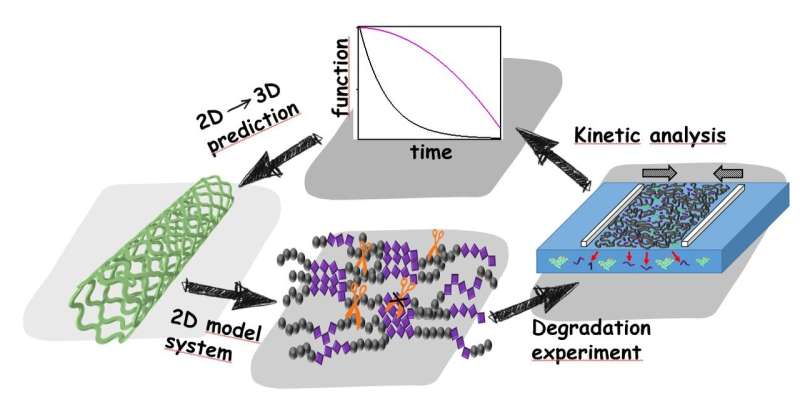Predicting the degradation behavior of advanced medical devices

Polymer materials play a vital role in today's medicine. While many applications demand long-lasting devices, others benefit from materials that disintegrate once their job is done. The design of such materials largely depends on the capability to predict their degradation behavior.
A team of researchers at the Helmholtz-Zentrum Geesthacht led by Prof. Andreas Lendlein established a method to faster and more reliably predict the degradation of these polymer materials with sophisticated molecular architectures. The results have been reported today in the first issue of the journal Cell Reports Physical Science.
With the so-called Langmuir technique, the authors transfer the material into a 2-D system, and thereby circumvent the complex transport processes that influence the degradation of three-dimensional objects. They created analytical models describing different polymer architectures that are of particular interest for the design of multifunctional implants and determined the kinetic parameters that describe the degradation of these materials.
In the next step, the scientists want to use these data to carry out computer simulations of the decomposition of therapeutic polymer devices. Regulatory authorities already prescribe computer simulations of the performance of such devices, for example for some stents. The insights gained by the 2-D degradation studies are certain to improve these simulations. By introducing a method to quickly understand and predict the degradation of polymer materials, the HZG researchers are contributing substantially to establishing innovative, multifunctional polymers for regenerative medicine.

Background—Multifunctional Biomaterials
An implementation of degradability can be especially helpful for implants such as sutures or staples. These objects are only needed temporarily as a mechanical support. Future medical implants are expected to perform much more complex tasks. These degradable devices will for example be able to be programmed in a compressed shape and in this way implantable by minimally invasive techniques, release a drug that supports the healing process, recruit the right cells to its surface and report back on the progress of the recovery. Here degradation is only one out of several functions that are integrated in the materials. Yet, degradation is highly critical, because it changes the material on a molecular level. In order to implement multiple functions into a material, its molecular structure is designed in a distinct, often complex way. Understanding how degradation affects this molecular architecture is key to ensuring that all the functions are executed as intended. The thin layer method presented in the study can have a transformative role for designing such degradable polymers.
More information: Rainhard Machatschek et al, Quantitative Model and Thin Film Studies Relating Molecular Architecture and Degradation of Multifunctional Materials, Cell Reports Physical Science (2020). DOI: 10.1016/j.xcrp.2019.100009
Provided by Helmholtz Association of German Research Centres



















